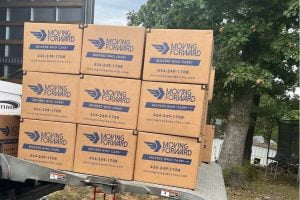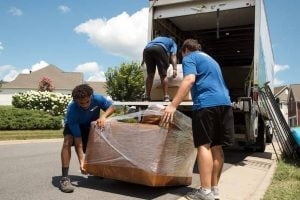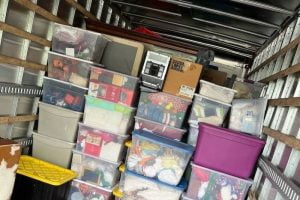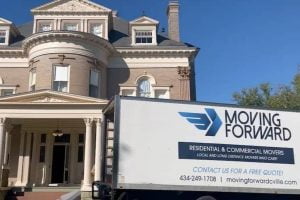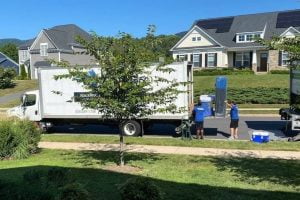Moving a house long distance requires careful planning and organization. From packing belongings to coordinating logistics, the process can be complex but manageable with the right approach. To successfully move a house long distance, homeowners should start by decluttering, creating a detailed timeline, and researching reputable moving companies.

Proper preparation is key to a smooth long-distance move. This includes sorting through possessions, packing essentials separately, and labeling boxes clearly. Obtaining necessary packing materials like boxes, tape, and bubble wrap well in advance can help streamline the packing process.
Hiring professional movers experienced in long-distance relocations can alleviate much of the stress associated with such a move. These experts can handle the heavy lifting, transportation, and even provide additional services like packing and unpacking. Researching and comparing quotes from multiple moving companies ensures the best value and service for this significant undertaking.
Planning Your Long-Distance Move

Proper planning is crucial for a successful long-distance move. A well-organized approach helps reduce stress and ensures a smooth transition to your new home.
Creating a Comprehensive Moving Checklist
Start by creating a detailed moving checklist at least 8 weeks before your move date. List all tasks, from packing to setting up utilities at your new place.
Prioritize items based on urgency and complexity. Include deadlines for each task to stay on track.
Break down large tasks into smaller, manageable steps. For example, divide packing into room-by-room tasks.
Keep the checklist visible and update it regularly. Cross off completed items to maintain motivation and track progress.
Choosing the Right Long-Distance Movers
Research potential moving companies at least 6 weeks before your move. Look for licensed and insured movers with positive customer reviews.
Obtain at least three in-home estimates from different companies. Compare services, prices, and insurance options.
Ask about their experience with long-distance moves and any specialized services they offer.
Verify the company's credentials with the Federal Motor Carrier Safety Administration (FMCSA).
Book your chosen mover as early as possible to secure your preferred date and potentially get better rates.
Understanding the Moving Process
Familiarize yourself with the long-distance moving process. Typically, it involves:
- Packing and loading your belongings
- Transporting items to your new location
- Unloading and unpacking at the destination
Be aware that long-distance moves may take several days or even weeks, depending on the distance and route.
Discuss the estimated delivery window with your movers. Plan for potential delays and have essentials with you during transit.
Understand the valuation and insurance options available for your belongings during the move.
Executing the Move

Proper execution is crucial for a successful long-distance move. Careful coordination, efficient packing, and safe transportation form the foundation of a smooth relocation process.
Coordinating Logistics for the Move
Begin by creating a detailed timeline for the move. Contact utility companies to schedule disconnections at the old home and connections at the new location. Hire a reputable moving company specializing in long-distance relocations. Obtain necessary permits for parking moving trucks in both locations.
Coordinate with the moving company to confirm dates, times, and any special requirements. Arrange for temporary storage if needed. Create a floor plan of the new home to guide furniture placement.
Keep important documents and valuables separate from items to be loaded onto the moving truck. Prepare a "first night" box with essentials for immediate use upon arrival.
Packing Strategies for Efficiency
Start packing non-essential items several weeks before the move. Use sturdy boxes and quality packing materials. Label each box clearly with its contents and intended room in the new home.
Pack room by room to maintain organization. Disassemble large furniture pieces and keep hardware in labeled bags. Use blankets or bubble wrap to protect fragile items.
Create an inventory list of all packed items. Take photos of valuable possessions for insurance purposes. Pack a separate box of essentials for the journey, including snacks, toiletries, and a change of clothes.
Transporting Your Belongings Safely
Ensure all boxes are properly sealed and stacked securely in the moving truck. Use furniture pads and straps to prevent shifting during transit. Load heavier items first and distribute weight evenly.
For moves over 12 hours away, consider using a professional moving company with experience in cross-country relocations. They have the expertise to handle long-distance logistics and potential challenges.
Track the progress of your belongings during transit. Many moving companies offer GPS tracking services. Coordinate with the movers to establish a clear communication plan for updates along the route.
Upon arrival, inspect all items for damage before signing off on the delivery. Unpack essentials first and gradually settle into the new home over the following days or weeks.
Settling into Your New Home

Transitioning to a new home after a long-distance move requires patience and organization. Unpacking strategically and exploring your new surroundings will help you adjust smoothly.
Unpacking and Organizing Post-Move
Start by unpacking essential items first. Set up your bedroom, bathroom, and kitchen to create functional living spaces immediately. Unpack one room at a time to avoid feeling overwhelmed.
Create a system for organizing belongings as you unpack. Use labels, and designated spaces to keep things tidy.
Set up utilities and internet service promptly to ensure your new home is fully functional. Change your address with important contacts and service providers.
Gradually personalize your space with familiar decor and photos to make it feel like home. Clean thoroughly as you unpack to start fresh in your new environment.
Starting Over in a New Location
Familiarize yourself with your new neighborhood. Take walks or drives to locate important amenities like grocery stores, pharmacies, and healthcare providers.
Research local community groups, clubs, or classes aligned with your interests. Joining these can help you meet people and establish a social network.
Explore local attractions, parks, and restaurants to discover what your new area has to offer. This helps create positive associations with your new home.
Be open to new experiences and meeting new people. Introduce yourself to neighbors and coworkers to start building connections in your new community.
Establish new routines that incorporate aspects of your new environment. This might include finding a new gym, coffee shop, or preferred commute route.
Cost-Saving Tips for Long-Distance Moves
Moving long-distance can be expensive, but there are ways to reduce costs. Start by decluttering ruthlessly. Sell, donate, or discard items you no longer need to minimize the volume of belongings you'll transport.
Compare quotes from multiple moving companies. Look for discounts or promotions, especially during off-peak seasons. Consider a hybrid move, where you pack and load, but professionals handle the transportation.
Collect free packing materials from local stores or online marketplaces. Use clothing, towels, and linens as padding for fragile items to save on bubble wrap.
Pack efficiently to maximize space and reduce the number of boxes. Disassemble furniture when possible to minimize the required truck space.
If flexible, choose a move date during the off-season (typically October to April) when rates are generally lower. Mid-week and mid-month moves are often cheaper than those at month-end or on weekends.
Consider a portable moving for a more budget-friendly option. You load and unload, while the company handles transportation.
For very tight budgets, renting a truck and driving it yourself can be the most economical choice. Enlist friends or family to help with loading and unloading to save on labor costs.
Plan your route carefully to minimize fuel costs and overnight stays. Pack snacks and meals to avoid expensive road food. Use apps to find the cheapest gas prices along your route.



